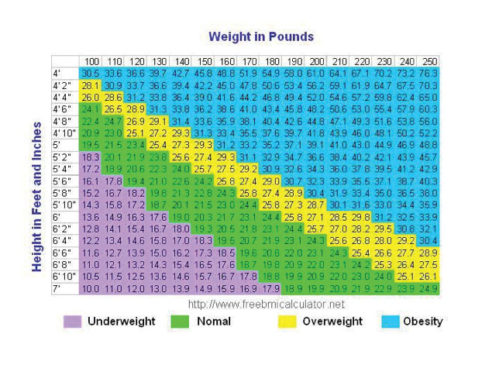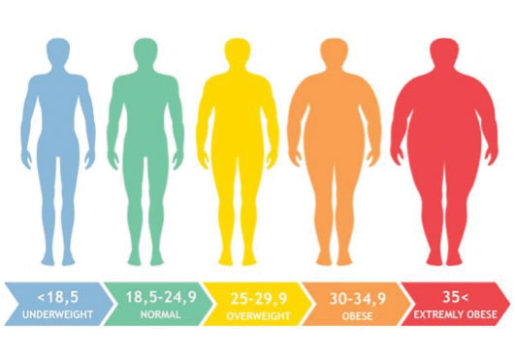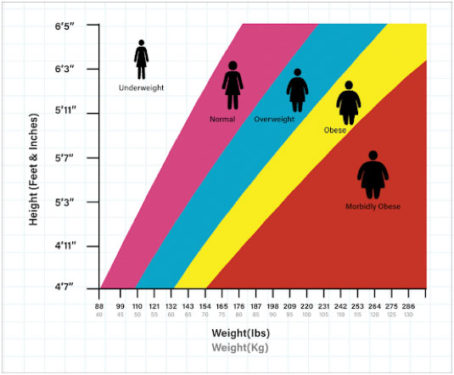By Mohammad Ahrar, PhD
Introduction
According to medical research, “healthy” weight is directly correlated to good health. There are some guidelines established by the U.S. government, as well as different research institutions, that describe the advantages of healthy weight and the consequences of unhealthy weight. The most commonly used guideline for healthy weight is the Body Mass Index (BMI) which gives a fairly accurate assessment of the percentage of fat in the body and whether a person’s weight is in a healthy range or not.

While research does not definitively conclude that people with a healthy weight live longer than those who are overweight, research does raise a red flag for people who are obese. In this article, we will review factors that contribute to unwanted weight gain and how to maintain a healthy weight.
How to Determine Your Ideal Weight on a BMI Chart
BMI is an index based on the ratio of an individual’s weight and height. It is a simple way to know if a person’s weight is in the healthy range. Samples of BMI charts are shown in the figures below. For example, in Figure 1, find your height on the left column and your weight on the top row. The BMI values for healthy weight are shown in the green zone. A range of 18.5 to 24.9 is considered healthy. If the index values fall in the yellow or blue area, you may be overweight or obese. You can also use the chart in a different way. If you want to see what your healthy weight should be, use the values in the green zone for your height and see the weight on the top row that is directly above the index (24.9). That weight is the best estimate of what your maximum healthy weight should be. There are also online sources that automatically calculate BMI using your height and weight (see References 2, 3). For more information about BMI, see Peyk #166.
The Consequences of Extra Weight
Being overweight and obesity are not the same. Excess weight can vary in people and a few extra pounds may not be a big issue. The problem is that being overweight can end up in obesity. Doctors refer to obesity as a serious, chronic disease that can inflict substantial harm to a person’s health.
Research from the Harvard School of Public Health shows that, statistically, people who are obese develop higher blood pressure, high blood cholesterol, atherosclerosis (build up of plaque in the arteries), and coronary heart disease. It has also been shown that strokes occur more often in people who are obese compared to those who are not obese.
Further, research from the Mayo Clinic and Johns Hopkins University indicates that obesity is the major cause of insulin resistance and type-2 diabetes. Even moderate obesity dramatically increases the risk of diabetes. Sleep apnea and respiratory problems are more prevalent in people who are obese, and people with extremely high BMI are also more at risk for breathing problems, certain cancers, and gallbladder disease. Mental illness such as clinical depression, anxiety, and other mental disorders are more common in those who are obese. Other studies have shown that obesity can affect the knees and hips because of the stress placed on the joints by extra weight. Most of these problems intensify as we age, but by then, it may be too late to reverse the problems. With regard to cancer risk, other research shows that overweight women are more at risk for breast and uterus cancer, and overweight men are at higher risk for colon and prostate cancer.
Risk Factors that Contribute to Weight Gain
1- Family Inheritance
The genes you inherit from your parents may affect the amount of body fat you store and how you metabolize energy (how efficiently your body converts food into energy). Genes are small segments of the DNA that control the synthesis of enzymes and proteins. Enzymes run the chemical reactions in the cells to produce energy and are involved in many other reactions.
Studies indicate that some enzymes may not work the way we like. Some enzymes use nutrients such as glucose to convert to fat, rather than use it as the source of energy. Therefore, people who have genes that activate production of such enzymes are more prone to develop more fat in the body. People have different DNA, and different genes. So, energy metabolism and production of fat in the body will not be the same in everyone. People who have these genes in their family should be very careful about their eating habits and their lifestyle.
2- Dietary Influence
a- Carbohydrates Foods high in carbs such as bread, rice, potatoes, pasta, and sugary foods and drinks are usually highly digestible, and sugar absorbs into the bloodstream rather fast. The carbohydrates in food break down into simple sugars, such as glucose, and absorb as such. As the level of glucose increases in the blood, insulin is released from the pancreas to facilitate the entry of glucose into the cells.
How do sugars convert to fat? Most cells in the body use glucose to produce energy. Glucose is also the main source of fuel for the brain. But not all tissues of the body react the same when it comes to energy metabolism. The effect of hormones such as insulin can also differ in different tissues. In the fat cells, insulin triggers formation of some enzymes that produce more fat. Additionally, insulin inhibits the breakdown of fats in adipose tissue by inhibiting the enzyme lipase that breaks down fats (triglycerides) to release fatty acids. When fatty acids are not available to the cells to burn and produce energy, the fatty acids in fat cells are converted to fat molecules. As billions of fat cells in the body grow bigger and bigger, extra weight develops, which can eventually lead to obesity. More information about carbs is discussed in Peyk #165b- Fats Fats and oils are made of subunits of fatty acids and glycerol. Fatty acids (FA) are made up of a chain of carbon atoms attached to a hydrogen atom. When three fatty acids attach to a glycerol, the compound is called a triglyceride. Most fats in food and in the human body are in the form of triglycerides. As you consume fats in your diet, the fat molecules are broken down into fatty acids and glycerol by the pancreatic enzyme and are absorbed through the small intestine (see further discussion in Peyk #159). Inside the body cells, a series of intracellular enzymes use the carbons in the fatty acids to produce energy. The longer the chain of fatty acids, the more energy they produce. On average, fats produce twice as much energy as carbs.
Excess energy production in the body, either from carbohydrates or from fat or even from protein source, will be stored as fat in fat tissues which will result in weight gain. Gaining weight does not happen overnight; it takes months and years before you become obese. Therefore, people who try to manage their healthy weight should not expect to lose extra weight overnight.
c- Portion Size Probably the most important risk factor for gaining weight is getting into the bad habit of eating large portions of food. Paying attention to portion size may also be the easiest way to control weight. (The importance of portion size in healthy weight is discussed in Peyk #189). Keep in mind the obvious fact that a plateful of cooked rice (about 2 cups) has twice as many calories as half a plate. The same is true with any other food.
If your daily energy requirement is 2000 Calories, you can easily fulfill that amount of energy by eating smaller portions of any foods that you like and still maintain your healthy weight. For example, if you like ice cream, instead of having a big portion that provides 400 Calories, you can enjoy a small cone of ice cream that provides 100 Calories. (Information about the caloric value of selected foods and energy requirements based on age and physical activities is discussed in Peyk #167.)
3- Lack of Physical Activity
Medical studies emphasize exercise to maintain a healthy weight. Engaging in sports, daily walking, working around the house, even walking up the stairs, and outside activities can burn calories. A sedentary lifestyle, such as sitting on the couch watching TV or being in front of a computer for long hours, can be a risk factor for gaining weight and eventual obesity. Muscles use more energy than any other tissues in the body. The more muscles used during any physical activity, the more energy is used up (see Peyk #166).
The American College of Sports Medicine suggests that moderately intensive activities, such as a minimum of 30 to 60 minutes of fast walking most days of the week, provide most of the health benefits and can control weight gain. The activities need not be continuous to provide benefits; in other words, 60 minutes of walking can be accrued in several 10-15 minute walks. (Please visit Peyk #168 for more information about the benefits of exercise on brain functions, the cardiovascular system, the immune system, and quality of life.)
Summary
Healthy weight is associated with the general health of the body. Being overweight can have a long-term effect on joints and other organs of the body. Obesity is a serious chronic disease and has severe consequences on one’s health. Moderation in food consumption and paying attention to portion sizes of meals and engaging in physical activities can reduce the risk of obesity. Having an ideal weight provides self-satisfaction. Weight control can be easy and fun. Sharing a large portion meal at a restaurant, cutting down on unhealthy snacks, plus a moderate daily physical activity will open the path for prevention of gaining extra pounds to help you reach your ideal weight. It is your decision.
Selected references:
1- https://www.hsph.harvard.edu/obesity-prevention-source/obesity-consequences/
2- http://www.nhlbi.nih.gov/health/educational/lose_wt/BMI/bmicalc.htm
3- https://www.hopkinsmedicine.org/gim/fellowship/obesity_research.html
4- Lutz, Carroll and Przytulski, K., Nutrition and Diet Therapy: Evidence-Based Applications, 4th Ed. F. A Davis Company, Philadelphia (2006).
5- http://www.vivo.colostate.edu/hbooks/pathphys/topics/hexose_xport.html

Figure 1- A general Body Mass Index (BMI) chart based on weight (in pounds) and height (in feet and inches).

Figures 2- This graph shows the range of BMI for a normal or healthy man in green.
The BMI values between 18.5 to 24.9 are a good estimate of a healthy or normal weight.

Figure 3- This is another type of chart showing the BMI for women. To see if your weight falls in a normal weight zone, find your height on the left column, and draw a line from the border of the red zone and the blue zone down to the weight line below the chart. This chart provides a good estimate of what your maximum weight should be.


















